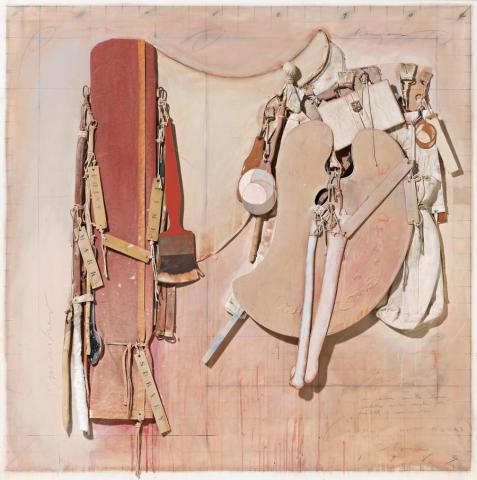SADDLE WITH BONES, 1983
TIM STORRIER
mixed media on board
151.5.x 151.0 cm
signed lower right: Storrier / 1983
Joseph Brown Gallery, Melbourne
Wesfarmers Art Collection, Perth, acquired from the above in 1984 (label attached verso)
The Song of the Lamb: The Wesfarmers Collection of Australian Art, Art Gallery of Western Australia, Perth, 19 August – 2 October 1989
Gooding, J., Topliss, H., Sharkey, C., and Horridge, N., The Song of the Lamb: The Wesfarmers Collection of Australian Art, Art Gallery of Western Australia, Perth, 1989, p. 103 (illus.)
Tim Storrier is the quintessential painter traveller of contemporary Australian art. Had he been born in the early nineteenth century he would have been an artist assigned to any number of the survey expeditions into the interior during the colonial era to chart the vast unexplored territory. As a contemporary artist he has commenced his own expeditions, both physical and psychological journeys, into the desert landscape of Australia and later North Africa and into his internal world as an artist and a man. In the early 1980s Storrier embarked upon a series of trips into the desert where he would construct three-dimensional scenes against the mysterious horizon line and then spectacularly set them alight, documenting each scene as it burnt down to its final embers. It was here that the first series of burning ropes were conceived and later constructed as the Blaze Line paintings, which formed the core of his Burning of the Gifts exhibition at Australian Galleries in 1989. These were in effect relief paintings containing diverse paraphernalia of the artist's campsite, such as bottles and bones, dangling from the burning ropes.
Saddle with Bones 1983 is one of the earliest expressions of this series and is one of the most resolved examples of his saddle 'paintings'. These works were first shown at Fischer Fine Art, London, where the reviewer commented that 'each tiny nucleus of possessions has the well worn, well cared for look that instantly suggests long periods of solitary, purposeful travel and is also a poignant comment on the frailty of man amid the immensity of nature.'1 It could also be regarded in the canon of conceptual pop art as an assemblage along the lines of the famous Jasper Johns collages in which all manner of real world materials such as flags, maps and letters were fixed on the surface under layers of encaustic and oil paint. In Saddle with Bones, Storrier has included all the accoutrements of his life as a painter traveller as though it is hanging from his saddle like a gold field stinker. There is the canvas tent, brushes, a spoon, various water canteens, saddle packs, his artist's palette and of course, dangling bones to represent mortality. He alludes to the transience of life in his pencil notes consciously scrawled lower right, 'an idea with bones, saddle and maybe the possibility of continuation...'
The theme of the artist laden with not only his tools of trade but also with the burdens of his own past and that of art history itself has always resonated through Storrier's work. It found full expression in his 2012 Archibald Prize winning self-portrait The Histrionic Wayfarer (after Bosch). Here the 'artist as wayfarer' is depicted in his desert landscape laden with an overwhelming surfeit of equipment including maps, compass, brushes, tent, canvas, paintbox, hat, telescope, funnel and dog. Like Saddle with Bones it appears like a clever summation of the artist himself, faceless but ever present.
1. Philpotts, B., 'Saddle Provisions, Tools for the Primary Surveyor', in Arts Review, 18 March 1983
LARA NICHOLLS
